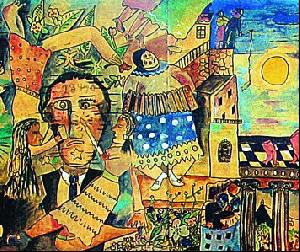
“I saw the world…It started in Recife”. Panel from the 1920’s by Pernambuco artist Cícero Dias, which is, in itself, a manifesto
FAPESP and the Museum of Fine Arts of Houston (MFAH) signed an agreement to integrate Brazil into a major international program for the recovery and digitization of documents on Latin American art. Called Art in Brazil – Critical 20th Century Texts, the Brazilian portion of the program is being coordinated by Prof. Ana Maria de Moraes Belluzzo from the School of Architecture and Urbanism (FAU – Faculdade de Arquitetura e Urbanismo) at the University of São Paulo (USP), and will receive a R$1.3 million grant in the first two years of the agreement. This sum will be split between FAPESP and the US museum. The USP team will select and digitize primary and rare documents, such as manuscripts, letters and manifestos produced by Brazilian artists and critics in the early decades of the 20th century until the 1980’s.
The material will be added to texts of a similar nature that have been gathered since 2003 by expert teams in Argentina, Chile, Mexico, Colombia, Peru, Venezuela and also in the USA , as part of the 20th Century Documents – Latin American and North American Latin Art, coordinated by the International Center for the Arts of the Americas (ICAA), connected to the Houston museum. This entire collection will be available in 2008 on the MFAH web page, in the form of a public database, and will form the basis of a collection of books in English, Portuguese and Spanish about Latin American art.
This is a very ambitious, well-structured and well-organized project, states Carlos Vogt, FAPESP’s president. “The documents will allow one to see Latin American art in a clearer but also more complex way, by enabling the development of didactic and educational activities at teaching institutions in the participating countries. It is yet one more example of the fact that education and culture can never be divorced from each other”, says Vogt. The program was devised by the MFAH, in conjunction with the formation of a collection of Latin American art, to meet a demand from the public and art historians in the USA, given that they are very familiar with European art, but know very little of Latin American artistic movements. The aim is to fill this information gap and break a vicious circle that hinders research into the subject and causes the works of art to be of less value.
The Houston museum’s geographical location, in the border state of Texas, showed this gap particularly well. “Sixty percent of our school-age children have Latin forebears, but the schools lack information to be able to show them what Latin art is”, says Peter Marzio, who has been the director of MFAH for more than two decades. Marzio became aware of this need as early as 1980, when he began looking for the best works by US artists of Latin origin in order to put together an exhibition, but he found that very little was known about Latin American artistic movements.
In 2001, the museum created the ICAA with the aim of disseminating and studying Latin American art in the USA. “The public knows very little about artists in Argentina, Brazil or Colombia. They think that everything comes from Mexico and, if they have to mention someone, they recall Frida Kahlo”, say Mari Carmen Ramirez, one of the 20 curators of the Houston museum and the person in charge of the ICAA. “Our idea is to establish a comparative base of the history of art in more than 20 nations with a broad variety of ethnic and cultural traditions, but that nevertheless share a history of colonization.”
The program “20th Century Documents – Latin American and North American Latin Art” works with artists’ texts such as manifestos, critical texts, testimonials and letters that can provide researchers with input for the understanding of artistic movements. By the end of the year, they expect to have gathered six thousand documents in the participating countries. The USP team has pre-selected 200 documents to work with. They are texts such as a letter from Ferreira Gullar to Mário Pedrosa, dated February 1959, which deals with the Neoconcrete Manifesto which launched other avant-garde artists that year. Or a handmade book of collages, produced in 1963 by the painter and sculptor Lygia Clark, (1920-1988), in which she develops the concepts underlying some of her techniques. Or Escultura Popular Brasileira (Popular Brazilian Sculpture) published in 1944, in which architect Luiz Saia analyzes a set of works collected in 1938 in the Northeast by a folkloric research mission at the São Paulo Department of Culture, headed, at the time, by Mário de Andrade.
“The artists’ writings are very important for research, because they are based on experimentation and outline analyses that critics would never have assumed”, explains Ana Maria Belluzzo. “The document is a means, not an end, because the texts always refer to the works of art, even when they don’t mention them. Art history establishes a relationship between the work of art and the text.” For the professor, the project will allow the history of this part of the 20th century to be rethought and written about differently. “It will be possible to develop one’s thoughts based on the views that artist and critics had at the time and to see how certain issues appeared throughout decades. We cannot think about things that happened in 1930 with a 2007 mind”, she states.
Republish